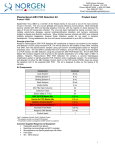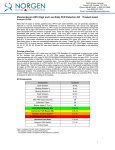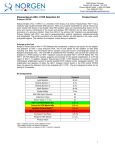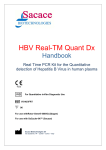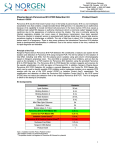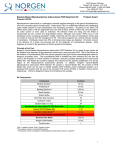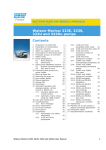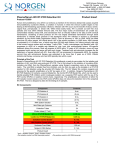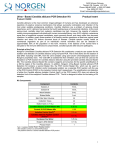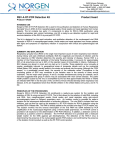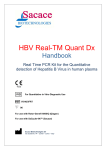Download Plasma-Serum HBV PCR Detection Kit - Protocol
Transcript
3430 Schmon Parkway Thorold, ON, Canada L2V 4Y6 Phone: 866-667-4362 • (905) 227-8848 Fax: (905) 227-1061 Email: [email protected] Plasma-Serum HBV PCR Detection Kit Product Insert Product # 29800 The Hepatitis B virus (HBV) is mainly transmitted via blood or blood products. In addition, sexual, oral and perinatal infections are also possible. Early symptoms of the infection include appetite loss, vomiting and abdominal symptoms, with approximately 10-20% of those patients developing fever as well as rheumatoid joint and muscle pain. Jaundice, which may be accompanied by itching, will then develop within 2-14 days. Fulminant hepatitis then occurs in about 1% of all infected patients, which in severe cases may be fatal. Of those individuals infected by HBV, 5-10% will develop chronic liver inflammation which may progess to cirrhosis of the liver or in the worst case, primary liver cell carcinoma. The HBV virus is a hepadnavirus that has a circular genome composed of partially doublestranded DNA. Principle of the Test Norgen’s Plasma-Serum HBV PCR Detection Kit constituents a ready-to-use system for the isolation and detection of HBV using end-point PCR. The kit first allows for the isolation of total DNA, including viral DNA, from the plasma-serum samples using spin-column chromatography based on Norgen’s proprietary resin. The viral DNA is isolated free from inhibitors, and can then be used as the template in a PCR reaction for HBV detection using the provided 2X HBV PCR Master Mix. The 2X HBV PCR Master Mix contains reagents and enzymes for the specific amplification of a 314bp region of HBV. In addition, Norgen’s Plasma-Serum HBV PCR Detection Kit contains contains a second Mastermix, the Control 2x PCR Master Mix, which can be used to identify possible PCR inhibition and/or inadequate isolation via a separate PCR reaction with the use of the PCR control (PCRC) or Isolation Control (IsoC), respectively. The amplification and detection of either the HBV Isolation Control (IsoC) or the PCR control (PCRC) does not reduce the detection limit of the analytical HBV PCR. The kit is designed to allow for the testing of 24 samples. Kit Components: Component Contents Lysis Solution 30 mL Binding Solution 1 6 mL Binding Solution 2 5 mL Wash Solution 22 mL Elution Buffer 3 mL Mini Filter Spin Columns 24 Collection Tubes 24 Elution tubes (1.7 mL) 24 HBV 2X PCR Master Mix 0.35 mL Control 2x PCR Master Mix 0.35 mL Isolation Control (IsoC)*a HBV Positive Control (PosC)* 0.3 mL b 0.1 mL Nuclease-Free Water 1.25 mL Norgen’s DNA Marker 0.1 mL Product Insert 1 *IsoC = Isolation Control; PosC= Positive Control a The isolation control is a cloned PCR product b The positive control is a fragment of HBV cloned in a plasmid 1 Customer-Supplied Reagents and Equipment • Disposable powder-free gloves • Benchtop microcentrifuge and 60°C incubator • Micropipettors and Sterile pipette tips with filters • PCR tubes • 96 – 100% ethanol Storage Conditions and Product Stability All buffers should be kept tightly sealed and stored at room temperature (15-25oC) for up to 1 year without showing any reduction in performance. The HBV 2X PCR Master Mix, Control 2X PCR Master Mix, Isolation Control (IsoC), and HBV Positive Control (PosC) should be kept tightly sealed and stored at -20oC for up to 1 year without showing any reduction in performance. Repeated thawing and freezing (> 2 x) should be avoided, as this may reduce the sensitivity. If the reagents are to be used only intermittently, they should be frozen in aliquots. General Precautions The user should exercise the following precautions while using the kit: • Use sterile pipette tips with filters. • Store and extract positive material (specimens, controls and amplicons) separately from all other reagents and add it to the reaction mix in a spatially separated facility. • Thaw all components thoroughly at room temperature before starting an assay. • When thawed, mix the components and centrifuge briefly. • Work quickly on ice. Quality Control In accordance with Norgen’s ISO 9001 and ISO 13485-certified Quality Management System, each lot of Norgen’s HBV 2X PCR Master Mix, Control 2X PCR Master Mix, Isolation Control (IsoC) and HBV Positive Control (PosC) are tested against predetermined specifications to ensure consistent product quality Product Use Limitations Norgen’s Plasma-serum HBV PCR Detection Kit is designed for research purposes only. It is not intended for human or diagnostic use. Product Warranty and Satisfaction Guarantee NORGEN BIOTEK CORPORATION guarantees the performance of all products in the manner described in our product manual. The customer must determine the suitability of the product for its particular use. Safety Information Ensure that a suitable lab coat, disposable gloves and protective goggles are worn when working with chemicals. For more information, please consult the appropriate Material Safety Data Sheets (MSDSs). These are available as convenient PDF files online at www.norgenbiotek.com. CAUTION: DO NOT add bleach or acidic solutions directly to the sample-preparation waste. The Lysis Solution, Binding Solution 1 and Binding Solution 2 contain guanidine hydrochloride, and should be handled with care. Guanidine hydrochloride forms highly reactive compounds when combined with bleach, thus care must be taken to properly dispose of any of these solutions. If liquid containing these buffers is spilt, clean with suitable laboratory detergent and water. If the spilt liquid contains potentially infectious agents, clean the affected area first with laboratory detergent and water, and then with 1% (v/v) sodium hypochlorite. 2 Plasma or Serum of all human and animal subjects is considered potentially infectious. All necessary precautions recommended by the appropriate authorities in the country of use should be taken when working with plasma or serum. 1. Protocol A. Specimen Collection, Storage and Transport Precaution: All samples have to be treated as potentially infectious material. 1. Specimen Collection and Sample Storage • Blood withdrawal causes injury of blood vessels (arteries, veins and capillaries). • Only safe and sterile material should be used. • For blood withdrawal appropriate disposables are available. For the vein puncture, too fine capillary needles should not be employed. • Venous blood withdrawal should be carried out on the appropriate parts of the elbow bend, the forearm or the back of the hand. • Blood has to be withdrawn with standard specimen collection tubes (red cap, Sarstedt or equivalent tube of another manufacturer). 5 - 10 ml EDTA blood should be withdrawn. Precaution: Samples of heparinised humans must not be used 2. Sample Storage • Whole blood should be separated into plasma and cellular components by centrifugation for 20 minutes at 800 - 1,600 x g within six hours. The isolated plasma has to be transferred into sterile polypropylene tubes. • The sensitivity of the assay can be reduced if you freeze the samples as a matter of routine or store them for a longer period of time. • Virus encapsulated DNA is stable for days if stored at +4°C, for weeks if stored at -20°C and even for months and years when stored at -70°C. 3. Sample Transport • Sample material should be transported in a shatterproof, leak-proof transport container as a matter of principle. Thus, a potential danger of infection due to a leakage of sample can be avoided. • The samples should be transported following the local and national instructions for the transport of pathogen material. • We recommend sample transport with a courier. The blood samples should be shipped cooled (+2°C to +8°C) and the separated plasma deep frozen (-20°C). 4. Interfering substances • Elevated levels of bilirubin (15 mg/dl) and lipids (800 mg/dl) and haemolytic samples do not influence the system. • Heparin (10 IU/ml) affects the PCR. Samples which have been collected in tubes containing heparin as an anticoagulant should not to be used. Also, samples of heparinised patients must not be used. B. Isolation of DNA from Plasma-Serum Notes: • Ensure that all solutions are at room temperature prior to use, and that no precipitates have formed. If necessary, warm the solutions and mix well until the solutions become clear again. • Clean, disposable gloves should be worn at all times when handling reagents, samples, pipettes, disposable tubes, etc. It is recommended that gloves are changed frequently to avoid contamination • All centrifugation steps are performed at room temperature. • A variable speed centrifuge should be used for maximum kit performance. If a variable speed centrifuge is not available a fixed speed centrifuge can be used, however reduced yields may be observed. 3 • Preheat an incubator or heating block to 60°C. • Prepare a working concentration of the Wash Solution by adding 50 mL of 95% ethanol (provided by the user) to the supplied bottles containing the concentrated Wash Solution. This will give a final volume of 72 mL. The labels on the bottles have a box that may be checked to indicate that the ethanol has been added. • Ensure that samples have not undergone more than one freeze-thaw cycle, as this may lead to DNA degradation. • Binding Solution 1 contains resin and must be mixed well before every pipetting. • This kit is suitable for the isolation of DNA from fresh or frozen serum or plasma prepared from blood collected on either Heparin, EDTA or citrate. • Isolation Control (IsoC) • An Isolation Control (IsoC) is supplied. This allows the user to control the DNA isolation procedure. For this assay, add the Isolation Control (IsoC) as indicated during the isolation procedure • The Isolation Control (IsoC) must not be added to the sample material directly. • Do not freeze and thaw the Isolation Control (IsoC) more than 2 times. • The Isolation Control (IsoC) must be kept on ice at all times during the isolation procedure. • The PCR components of the Plasma-Serum HBV PCR Detection Kit should remain at -20oC until DNA is extracted and ready for PCR amplification. • It is important to work quickly during this procedure. 1. 2. 3. 4. 5. 6. 7. 8. 9. 10. 11. 12. 13. In a 2mL tube add 400 µL Plasma/Serum sample. To each 400 µL Plasma/Serum sample add 1.2 mL of Lysis Solution. Mix well by vortexing for 15 seconds. Incubate the mixture from Step 2 for 10 minutes at 60oC. After incubation add 200 µL of Binding Solution 1 and mix well by vortexing for 15 seconds. (Note: Binding Solution 1 contains resin and must be mixed well before every pipeting) Centrifuge the mixture from Step 4 for 1 minute at 2,000 RPM, then carefully decant the supernatant in order to ensure that the slurry pellet is not dislodged. To the slurry pellet from Step 5 add 180 µL from Binding Solution 2 followed by the addition of 420 µL of 96-100% Ethanol (provided by the user) and 10 µL Isolation Control (IsoC). Mix well by vortexing for 15 seconds. Centrifuge the mixture from Step 6 for 1 minute at 2,000 RPM, then carefully decant the supernatant in order to ensure that the slurry pellet is not dislodged. To the slurry pellet from Step 7 add 1 mL Wash Solution, mix well by vortexing for 15 seconds and then centrifuge for 1 minute at 2,000 RPM. Carefully decant the supernatant in order to ensure that the slurry pellet is not dislodged. Repeat Step 8 to wash the slurry pellet for a second time. To the slurry pellet from Step 9 add 500 µL Wash Solution, Mix well by vortexing for 15 seconds. Transfer the entire mixture from Step 10 into a Mini Filter Spin column. Centrifuge for 1 minute at 14,000 RPM. Discard the flowthrough and reassemble the spin column with its collection tube; Spin the column, empty, for 2 minute at 14,000 RPM. Discard the collection tube; Transfer the spin column to a fresh 1.7 mL Elution tube. Apply 100 µL of Elution Buffer to the column and centrifuge for 2 minutes at 200 x g (~2,000 RPM), followed by 2 minute at 10,000 x g (~14,000 RPM). 4 C. HBV PCR Assay Preparation Notes: • Before use, suitable amounts of all PCR components should be completely thawed at room temperature, vortexed and centrifuged briefly. • The amount of HBV 2X Detection PCR Master Mix and Control 2X PCR Master Mix provided is enough for up to 32 PCR reactions (24 sample PCR, 4 positive control PCR and 4 no template control PCR). • For each sample, one PCR reaction using the HBV 2X Detection PCR Master Mix and one PCR reaction using Control 2X PCR Master Mix should be set up in order to have a proper interpretation of the results. • For every PCR run, one reaction containing HBV Positive Control and one reaction as no template control must be included for proper interpretation of results. • The recommended minimum number of DNA samples tested per PCR run is 6. • Using a lower volume from the sample than recommended may affect the sensitivity of the HBV Limit of Detection. 1. Prepare the PCR reaction for sample detection (Set #1, using HBV 2X Detection PCR Mastermix) and the PCR reaction for control detection (Set #2, using Control 2X PCR Mastermix) as shown in Table 1 below. The recommended amount of sample DNA to be used is 2.5 µL. However, a volume between 1 and 5 µL of sample DNA may be used as template. Ensure that one HBV detection reaction and one control reaction is prepared for each DNA sample. Adjust the final volume of the PCR reaction to 20 µL using the NucleaseFree Water provided. Table 1. PCR Assay Preparation PCR Components Volume Per PCR Reaction HBV 2X PCR Master Mix OR Control 2X PCR Master Mix 10 µL Sample DNA 2.5 µL Nuclease-Free Water 7.5 µL Total Volume 20 µL 2. For each PCR set, prepare one positive control PCR as shown in Table 2 below: Table 2. PCR Positive Control Preparation PCR Components Volume Per PCR Reaction HBV 2X PCR Master Mix OR Control 2X PCR Master Mix 10 µL HBV Positive Control (PosC) 10 µL Total Volume 20 µL 5 3. For each PCR set, prepare one no template control PCR as shown in Table 3 below: Table 3. PCR Negative Control Preparation PCR Components Volume Per PCR Reaction HBV 2X PCR Master Mix OR Control 2X PCR Master Mix 10 µL Nuclease-Free Water 10 µL Total Volume 20 µL D. HBV PCR Assay Programming 1. Program the thermocylcer according to the program shown in Table 4 below. 2. Run one step PCR. Table 4: HBV PCR Assay Program PCR Cycle Step Cycle 1 Cycle 2 (40x) Temperature o Step 1 95 C 3 min Step 1 94oC 15 sec Step 2 60oC 30 sec Step 3 Cycle 3 Cycle 4 Duration o 45 sec o 5 min 72 C Step 1 72 C Step 1 o 4C ∞ D. HBV PCR Assay Interpretation • For the analysis of the PCR data, the entire 20 µL PCR reaction should be loaded on a 1X TAE 2% Agarose DNA gel along with 10 µL of Norgen’s DNA Marker (provided). • The PCR products should be resolved on the 1X TAE, 2% Agarose gel at 150V for 30 minutes (Gel running time will vary depending on an electrophoresis apparatus). M A B C D E NegC 2000 1500 1000 750 500 300 150 Figure 1: A representative 1X TAE, 1.7% agarose gel showing the amplification of HBV at different concentrations (Target). The size of the HBV target amplicon corresponds to the 300bp band represented by the provided DNA Marker (M). Lanes A-E represents samples spiked with different HBV concentrations. 6 Figure 2: A representative 1X TAE 1.7% agarose gel showing the amplification of Isolation Control and PCR Control under different conditions using the Control 2X PCR Master Mix. The size of the Isolation Control amplicon and PCR Control amplicon correspond to 499 bp and 150 bp, respectively, as represented by the provided DNA Marker (M). Lanes 1 to 5 showed detection of both Isolation Control and PCR Control, suggesting that the DNA isolation as well as the PCR reaction was successful. Lane 6 showed only the detection of PCR Control suggesting that while the PCR was successful, the isolation failed to recover even the spiked-in Isolation control. NTC=Negative Control. Table 5. Interpretation of PCR Assay Results Input Type Positive Control Target Reaction Control Reaction HBV Target Band (300 bp) IsoC Band (499bp) PCRC Band (150 bp) X X X Valid X Valid X X Positive X X X Negative Negative Re-Test Negative Control Sample X Sample Sample Sample Sample Sample Sample Sample Interpretation X X X X X X Re-Test Positive Positive Re-Test ** For results obtained that are not covered in Table 5 above, please refer to the Troubleshooting Section. ** Ignore any bands that appear between the Isolation Control band and the PCR Control band E. Specificity • The specificity of Norgen’s Plasma-Serum HBV PCR Detection Kit is first and foremost ensured by the selection of the HBV-specific primers, as well as the selection of stringent reaction conditions. The primers were checked for possible homologies in GenBank published sequences by sequence comparison analyses. 7 F. Linear Range • • • • The linear range (analytical measurement) of Norgen’s Plasma-Serum HBV PCR Detection Kit was determined by analyzing a dilution series of an HBV quantitative standard ranging from 8.46 x 109 VP/µl to 1 x 10-1 IU/µl. Each dilution has been tested in replicates (n = 4) using Norgen’s Plasma-Serum HBV PCR Detection Kit on 1X TAE, 1.7% Agarose gels. The linear range of Norgen’s Plasma-Serum HBV PCR Detection Kit has been determined to cover concentrations from 0.5 VP/µl to at least 8 x 106 VP/µl Under the conditions of Norgen’s Plasma-Serum DNA Isolation procedure, Norgen’s PlasmaSerum HBV PCR detection Kit covers a linear range from 20VP/mL Plasma-Serum to at least 8 x 109 VP/mL Plasma-Serum. G. Frequently Asked Questions 1. How many samples should be included per PCR run? • Norgen’s Plasma-Serum HBV PCR Detection Kit is designed to test 24 samples. For every 6 samples, a Negative Control and a Positive Control must be included. It is preferable to pool and test 6 samples at a time. If not, the provided Negative Control and Positive Control are enough to run 3 samples at a time. 2. How can I interpret my results for a sample if neither the HBV PCR Control nor the HBV Isolation Control (IsoC) amplifies? • If neither the HBV PCR control nor the HBV Isolation Control (IsoC) amplifies, the sample must be re-tested. If the positive control showed amplification, then the problem occurred during the isolation, where as if the Positive control did not amplify the problem has occurred during the setup of the PCR assay reaction. 3. How should it be interpreted if only the HBV PCR control showed amplification but neither the HBV target nor the HBV Isolation Control (IsoC) amplified for a sample? • This indicates a poor isolation. The isolation procedure must be repeated. 4. How should it be interpreted if only the HBV Isolation Control (IsoC) was amplified in a sample? • The sample tested can be considered as HBV negative. 5. How should it be interpreted if only the HBV target and the HBV PCR control were amplified in a sample? • The sample tested can be considered as HBV positive. 6. How should it be interpreted if only the HBV target was amplified in a sample? • The sample tested can be considered positive. At HBV viral load, the HBV amplicon will be predominant and the HBV PCR control as well as the HBV Isolation control may not amplify. 7. How should it be interpreted if only the HBV PCR control and the HBV Isolation Control (IsoC) showed amplification? • The sample tested can be considered negative 8. Can I process a different Plasma-Serum volume? • The reagents provided with the isolation kit are only sufficient to process 24 Plasma-serum samples of 0.5mL each. 9. What If I added more or less of the specified reagents’ volume? • Adding less volume may reduce your DNA yields. Adding more may not affect the DNA yields EXCEPT if more Elution Buffer was added. Eluting DNA in higher volumes of Elution Buffer will result in diluting your DNA. 8 10. What If my incubation varied from the 10 minutes specified in the product manual? • Less than 10 minutes will result in lower DNA yields. More than 10 minutes may not affect your DNA yields. 11. What If I forgot to do a dry spin after my second wash? • Your first DNA elution will be contaminated with the Wash Solution. This may dilute the DNA yield in your first elution and it may interfere with your down stream applications. 12. What If I forgot to add the HBV Isolation Control (IsoC) during the isolation? • The isolation must be repeated. Technical Assistance NORGEN’s Technical Service Department is staffed by experienced scientists with extensive practical and theoretical expertise in sample and assay technologies and the use of NORGEN products. If you have any questions or experience any difficulties regarding Norgen’s Plasma-Serum DNA Isolation Mini Kit (Slurry Format) or NORGEN products in general, please do not hesitate to contact us. NORGEN customers are a valuable source of information regarding advanced or specialized uses of our products. This information is helpful to other scientists as well as to the researchers at NORGEN. We therefore encourage you to contact us if you have any suggestions about product performance or new applications and techniques. For technical assistance and more information, please contact our Technical Support Team between the hours of 8:30 and 5:30 (Eastern Standard Time) at (905) 227-8848 or Toll Free at 1-866-667-4362 or call one of the NORGEN local distributors (www.norgenbiotek.com) or through email at [email protected]. 3430 Schmon Parkway, Thorold, ON Canada L2V 4Y6 Phone: (905) 227-8848 Fax: (905) 227-1061 Toll Free in North America: 1-866-667-4362 ©2013 Norgen Biotek Corp. PI29800-4 9









